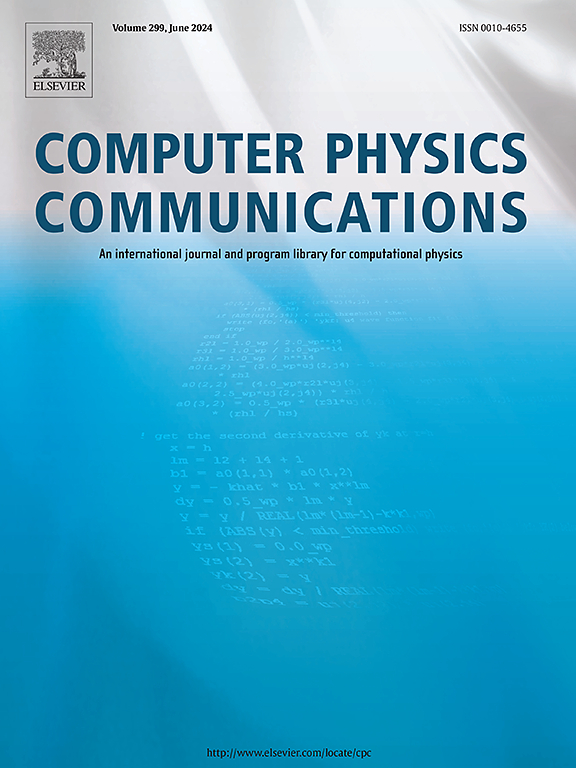Flowy: High performance probabilistic lava emplacement prediction
IF 3.4
2区 物理与天体物理
Q1 COMPUTER SCIENCE, INTERDISCIPLINARY APPLICATIONS
引用次数: 0
Abstract
Lava emplacement is a complex physical phenomenon, affected by several factors. These include, but are not limited to features of the terrain, the lava settling process, the effusion rate or total erupted volume, and the probability of effusion from different locations. One method, which has been successfully employed to predict lava flow emplacement and forecast the inundated area and final lava thickness, is the MrLavaLoba method from Vitturi et al. [1]. The MrLavaLoba method has been implemented in their code of the same name [2]. Here, we introduce Flowy, a new computational tool that implements the MrLavaLoba method in a more efficient manner. New fast algorithms have been incorporated for all performance critical code paths, resulting in a complete overhaul of the implementation. When compared to the MrLavaLoba code [1], [2], Flowy exhibits a significant reduction in runtime – between 100 to 400 times faster – depending on the specific input parameters. The accuracy and the probabilistic convergence of the model outputs are not compromised, maintaining high fidelity in generating possible lava flow paths and deposition characteristics. We have validated Flowy's performance and reliability through comprehensive unit-testing and a real-world eruption scenario. The source code is freely available on GitHub [3], facilitating transparency, reproducibility and collaboration within the geoscientific community.
flow:高性能概率熔岩就位预测
熔岩就位是一种复杂的物理现象,受多种因素影响。这些因素包括但不限于地形特征、熔岩沉降过程、渗出速率或总喷出量,以及从不同位置渗出的可能性。Vitturi等人的MrLavaLoba方法已成功用于预测熔岩流侵位、预测淹没面积和最终熔岩厚度。MrLavaLoba方法已经在他们的同名代码[2]中实现。在这里,我们介绍一种新的计算工具Flowy,它以更有效的方式实现了MrLavaLoba方法。所有性能关键代码路径都加入了新的快速算法,从而对实现进行了彻底的检查。与MrLavaLoba代码[1],[2]相比,根据具体的输入参数,Flowy的运行时间明显缩短了100到400倍。模型输出的精度和概率收敛性不受影响,在生成可能的熔岩流动路径和沉积特征方面保持了高保真度。我们通过全面的单元测试和真实的喷发场景验证了Flowy的性能和可靠性。源代码在GitHub[3]上免费提供,促进了地球科学界的透明度、可重复性和协作性。
本文章由计算机程序翻译,如有差异,请以英文原文为准。
求助全文
约1分钟内获得全文
求助全文
来源期刊

Computer Physics Communications
物理-计算机:跨学科应用
CiteScore
12.10
自引率
3.20%
发文量
287
审稿时长
5.3 months
期刊介绍:
The focus of CPC is on contemporary computational methods and techniques and their implementation, the effectiveness of which will normally be evidenced by the author(s) within the context of a substantive problem in physics. Within this setting CPC publishes two types of paper.
Computer Programs in Physics (CPiP)
These papers describe significant computer programs to be archived in the CPC Program Library which is held in the Mendeley Data repository. The submitted software must be covered by an approved open source licence. Papers and associated computer programs that address a problem of contemporary interest in physics that cannot be solved by current software are particularly encouraged.
Computational Physics Papers (CP)
These are research papers in, but are not limited to, the following themes across computational physics and related disciplines.
mathematical and numerical methods and algorithms;
computational models including those associated with the design, control and analysis of experiments; and
algebraic computation.
Each will normally include software implementation and performance details. The software implementation should, ideally, be available via GitHub, Zenodo or an institutional repository.In addition, research papers on the impact of advanced computer architecture and special purpose computers on computing in the physical sciences and software topics related to, and of importance in, the physical sciences may be considered.
 求助内容:
求助内容: 应助结果提醒方式:
应助结果提醒方式:


